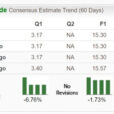Even though the US economy is literally booming, the US Treasury reported its highest budget deficit in six years.
The massive corporate and individual tax cuts passed by the Republican-controlled Congress late in 2017 and the increase in government spending agreed to in February has clearly escalated the fiscal deficit, as most economists expected.
This year, US GDP growth surged in the second quarter to 4.2% at an annual rate, the highest growth rate since mid-2014.
The US government’s fiscal year runs from October to September. Thus, the Administration ended its 2018 fiscal year with a $779 billion budget deficit, $113 billion higher than in the previous year.
In other words, the first full year of the government Budget under the control of President Donald Trump, the US generated the largest deficit since 2012.
Monthly Treasury Budget data are very volatile and are not seasonally adjusted, so the September surplus of $119 billion cannot easily be compared to the $214.1 billion deficit reported for August.
The Trump Administration and the Republicans argued that the tax cuts and spending increases would boost economic growth and jobs. They also claimed that America’s booming economy would increase government revenues, generating an important step toward long-term fiscal sustainability.
But an examination of the data in the following charts indicates, not surprisingly, that tax revenues are growing much more slowly than government spending, despite the booming economy.
Indeed, slowing government revenues were a far larger contributor to the rising deficit than higher spending. While federal outlays increased over the recent twelve months, the economy sped up, so outlays declined as a share of the economy declined from 20.7% in FY 2017 to 20.3% in 2018.
However, federal revenues rose by 0.4% over the past year, a pace much slower than in the 1.5% increase in the previous year. Between 2014 and 2015, revenues increased by 7.5%.













Leave A Comment